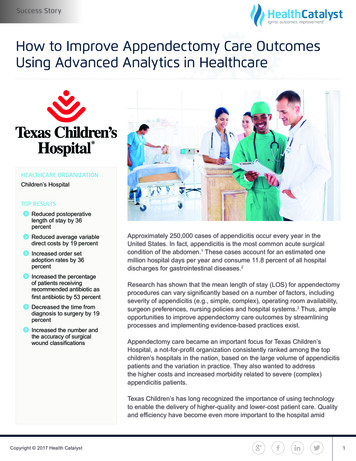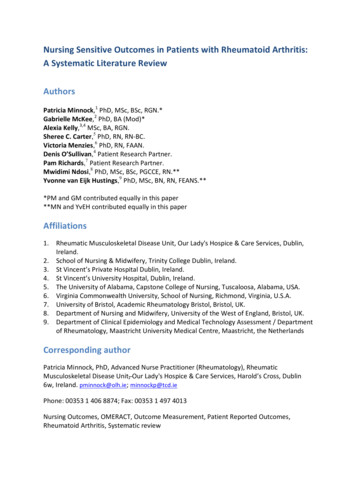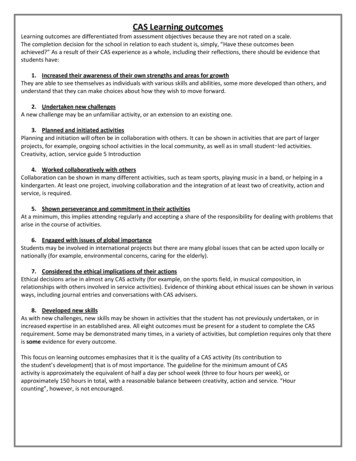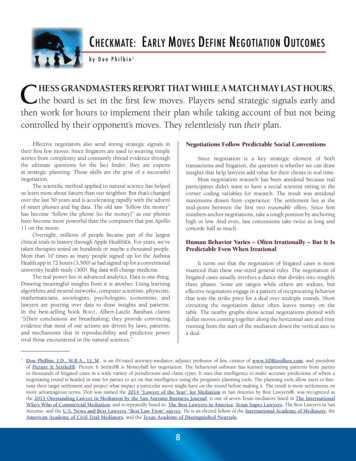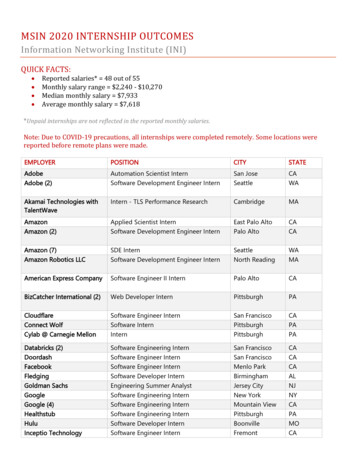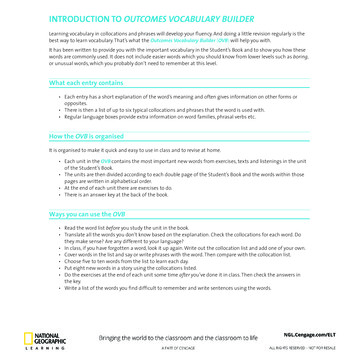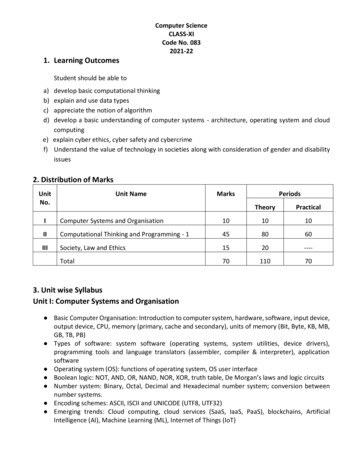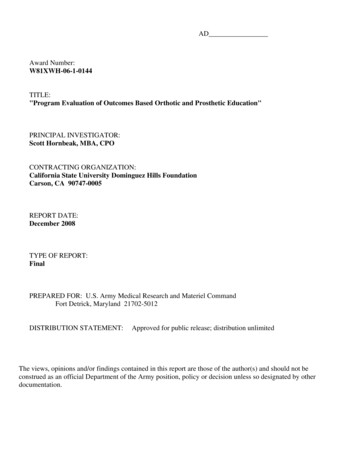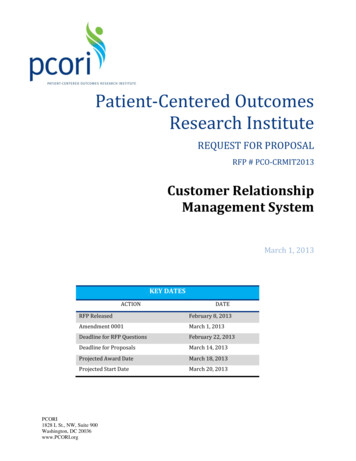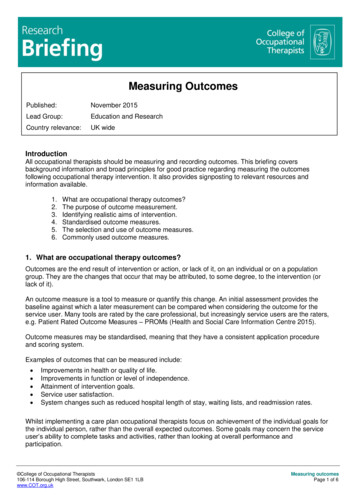
Transcription
Measuring OutcomesPublished:November 2015Lead Group:Education and ResearchCountry relevance:UK wideIntroductionAll occupational therapists should be measuring and recording outcomes. This briefing coversbackground information and broad principles for good practice regarding measuring the outcomesfollowing occupational therapy intervention. It also provides signposting to relevant resources andinformation available.1.2.3.4.5.6.What are occupational therapy outcomes?The purpose of outcome measurement.Identifying realistic aims of intervention.Standardised outcome measures.The selection and use of outcome measures.Commonly used outcome measures.1. What are occupational therapy outcomes?Outcomes are the end result of intervention or action, or lack of it, on an individual or on a populationgroup. They are the changes that occur that may be attributed, to some degree, to the intervention (orlack of it).An outcome measure is a tool to measure or quantify this change. An initial assessment provides thebaseline against which a later measurement can be compared when considering the outcome for theservice user. Many tools are rated by the care professional, but increasingly service users are the raters,e.g. Patient Rated Outcome Measures – PROMs (Health and Social Care Information Centre 2015).Outcome measures may be standardised, meaning that they have a consistent application procedureand scoring system.Examples of outcomes that can be measured include: Improvements in health or quality of life.Improvements in function or level of independence.Attainment of intervention goals.Service user satisfaction.System changes such as reduced hospital length of stay, waiting lists, and readmission rates.Whilst implementing a care plan occupational therapists focus on achievement of the individual goals forthe individual person, rather than the overall expected outcomes. Some goals may concern the serviceuser’s ability to complete tasks and activities, rather than looking at overall performance andparticipation. College of Occupational Therapists106-114 Borough High Street, Southwark, London SE1 1LBwww.COT.org.ukMeasuring outcomesPage 1 of 6
As the care plan nears completion, the focus often shifts from the achievement of individual goals to theoverall outcomes concerning that person’s occupational performance and participation. For convenience,outcomes are often measured at the point when interventions have just been completed. However, thepoint at which outcomes for the service user are best measured may be months after last contact withthe occupational therapist. This delay allows time for the service user to optimise the benefits theyachieve from occupational therapy interventions.The occupational therapist will also be concerned with measuring outcomes for secondary purposessuch as service management, service commissioning, information for central government (Centralreturns), clinical audit and research.2. The purpose of outcome measurementOutcome measurement can demonstrate the effectiveness of intervention for individual service users orpopulation groups, guiding further decision-making and/or intervention. The use of outcome measures,especially standardised measures, allows occupational therapists to build up and use a body of evidencefor occupational therapy.Standardised tools tend to be better recognised by those in other professions. They can help improvethe sharing and understanding of information in multidisciplinary teams and between teams when morethan one service is involved. The routine use of standardised tools also underpins the credibility ofinformation and reports provided to local managers and service commissioners.A recent trend is the development of national data sets that include outcome data, for example therecording and central aggregation of outcomes as part of the Access to Psychological Therapies (IAPT)programme.3. Identifying realistic aims of interventionHealth and social care services are provided to people with diverse conditions and individualcircumstances. Consequently there is a variety of overall aims relevant to different individuals. Forexample: Rehabilitation - to restore personal autonomy in those aspects of daily living considered mostrelevant by patients or service users and their family carers (Sinclair and Dickinson 1998).Habilitation - to achieve new levels of performance and participation, e.g. people with learningdisabilities.Reablement - to help people accommodate their illness or condition by learning or relearning theskills necessary for daily living.Adaptation – to adjust to a lower level of performance and participation, e.g. some people withneurological conditions.Prevention – to minimise the risk of deterioration or harm, e.g. joint protection for people witharthritis.Stabilisation – trying to maintain functioning or slow down expected deterioration, e.g. ChronicObstructive Pulmonary Disease.Palliative – to improve the quality of life of patients and families who face life-threatening illness, byproviding pain and symptom relief, spiritual and psychosocial support from diagnosis to the end of lifeand bereavement (WHO 2012). College of Occupational Therapists106-114 Borough High Street, Southwark, London SE1 1LBwww.COT.org.ukMeasuring outcomesPage 2 of 6
The above aims are not mutually exclusive. ‘Reablement’ and ‘Rehabilitation’ overlap, and may be usedwith different care groups. For example, reablement usually provides intensive input in the short-termwhereas rehabilitation is usually longer term.There are other frameworks for categorising the overall aims of care and intervention, which are broadlysimilar to the framework set out above. Wilcock’s ‘Occupation for Health’ (2001), for example, identifiesaims of adaptation following disability and handicap, rehabilitation, habilitation, restoration of health,prevention of Illness, and promotion of health.The aim provides the overall context for evaluating the effectiveness of interventions. Someone with adeteriorating condition, such as Alzheimer’s disease, may expect some improvement in functioning andquality of life when first receiving health and care services. Once their situation and care package hasbeen optimised then a more realistic aim will be to stabilise their level of functioning, or perhaps even tominimise the rate of deterioration as the illness progresses.Individual goals should contribute to the overall aim, and wherever possible be: Specific, Measurable,Agreed, Realistic and Timed (SMART). Interventions are often chosen to collectively contribute to theachievement of the current set of goals. In some instances there may be a single intervention for eachspecific goal.4. Standardised outcome measuresA ‘standardised’ outcome measure (as for standardised assessment tools) has a set, unchangingprocedure that must be used when carried out, as well as a consistent system for scoring. This ensuresminimal variation in the way it is carried out at different times and by different testers. The scoringsystem may also have been normatively standardised, meaning that the test has been used with a verylarge group of similar people, giving an average score or range of expected scores that the tester andthe service user can use to compare with their own results. Standardised tests have known levels ofreliability, validity, and utility, which ensure that therapists can select and use them appropriately andwith confidence in the results.5. The selection and use of outcome measuresPractitioners need to select an outcome measure that is appropriate for the specific identifiedmeasurement purpose. There isn’t and probably never will be a ‘one size fits all’ outcome measure for allfields of practice. This reflects the breadth of occupational therapy intervention and the diversity ofservice users’ circumstances and needs. Several outcome measures may be needed to providecomprehensive relevant information about the outcomes for each individual service user.Before selecting outcome measures practitioners need to consider the following: Existing data collection requirements for service commissioning, information required by centralgovernment and national agencies, and for local clinical audits.National guidance on assessment and outcome measurement in each area of practice, e.g. peoplewith Dementia, Diabetes, Falls, and Chronic Obstructive Pulmonary Disease.What do they want to measure – is there a tool that will do this precisely?Is the tool suitable for the service user’s condition, needs, setting, culture and background?Is the tool reliable and valid?Is the outcome measure sensitive enough to change in the individual? College of Occupational Therapists106-114 Borough High Street, Southwark, London SE1 1LBwww.COT.org.ukMeasuring outcomesPage 3 of 6
What training is required to use the outcome measure?Does the outcome measure require the use of particular equipment or a specific environment?Is the outcome measure easy to use in practice?Will the introduction of the outcome measure into the service be practicable?Are the results meaningful and useful/usable?There are articles, books and other resources that provide key details or reviews of the main assessmenttools and outcome measures used in health and social care services. These can assist practitioners tochoose appropriate tools for their service.When it is difficult to find an outcome measure that meets precise local requirements it is tempting toadapt a published tool or to develop a ‘home grown’ one based on local experience. This can be veryappealing and can appear to provide a quick solution. It may be relatively easy to implement, and havean acceptable degree of face validity, i.e. the outcome measure appears to measure what it says itmeasures.However, the process of developing a standardised outcome measure usually takes several years, andrequires a major research project with significant resources. So, a locally developed outcome measure isunlikely to have been standardised and cannot be relied on to be sufficiently valid or reliable.Practitioners should explicitly state when their results are derived from a locally developed tool to ensurethose results can be interpreted correctly by the service user and other professionals.The introduction of an outcome measure into routine clinical practice should be considered verycarefully, be part of the organisation’s business plans, and have the full support of senior management.Outcome measures may require the practitioner to complete training before using the tool, and possiblyregular refresher training. The training can be seen as a valid part of continuing professional and servicedevelopment, if it is going to meet the requirements of the service or the needs of the service-user.Some published tools have pre-printed forms to use. Practitioners need to ensure that they use theseaccording to any copyright and licensing conditions given.The results of an outcome measure must be recorded appropriately and comprehensively, and thenstored as part of the service-user’s care records. Please refer to College of Occupational TherapistsProfessional standards for occupational therapy practice (COT 2011), and the College’s Guidance:Record Keeping (COT 2010), with regards to assessment, evaluation and record keeping.With the increasing use of digital care records, and the inclusion of standardised tools as part of therecords, the outcomes of intervention may become easier to collect and analyse. There are countryspecific development programmes to design and implement digital care records in England, NorthernIreland, Scotland and Wales.Ideally, each assessment or outcome measure tool will have a corresponding digital template designedinto every digital care record system. Each template will have been designed to accurately mirrorexisting data collection methods, such as paper forms. Correctly designed templates will ensure thatassessment data can be accurately recorded in the individual digital care record whilst retaining the fullmeaning of that assessment data. The assessment information can then be viewed, analysed and usedfor individual clinical care, and for management reporting, clinical audit and research purposes. College of Occupational Therapists106-114 Borough High Street, Southwark, London SE1 1LBwww.COT.org.ukMeasuring outcomesPage 4 of 6
6. Commonly used outcomes measuresThe following are examples of some assessments and outcome measures commonly used byoccupational therapists.6.1 Assessment of Motor and Process Skills (AMPS)AMPS is a standardised, observational assessment that offers occupational therapists a uniqueapproach to the problem of how to conceptualise and assess occupational performance. When thepractitioner uses the AMPS, he or she is able to simultaneously evaluate a person's overall ability toperform domestic or instrumental activities of daily living and the quality of a person's motor and processskills. Occupational therapists are required to complete a course in order to administer AMPS. Moreinformation is available from: 6.2 Australian Therapy Outcome Measures (AusTOMs)The Australian Therapy Outcome Measures are designed for occupational therapists (and other healthprofessionals) to use with service users, of all ages and all diagnoses, to measure the outcome ofinterventions in terms of functioning, participation and well-being. More information is available from:http://austoms.com/about.6.3 Canadian Occupational Performance Measure (COPM)COPM is an individualised, person-centred measure for use by occupational therapists to detect changein a service user's self-perception of occupational performance over time. It is designed as an outcomemeasure for use with service users with a variety of disabilities and across all developmental stages. TheCOPM is standardised in that there are specific instructions and methods for administering and scoringth
following occupational therapy intervention. It also provides signposting to relevant resources and information available. 1. What are occupational therapy outcomes? 2. The purpose of outcome measurement. 3. Identifying realistic aims of intervention. 4. Standardised outcome measures. 5. The selection and use of outcome measures. 6. Commonly used outcome measures.

